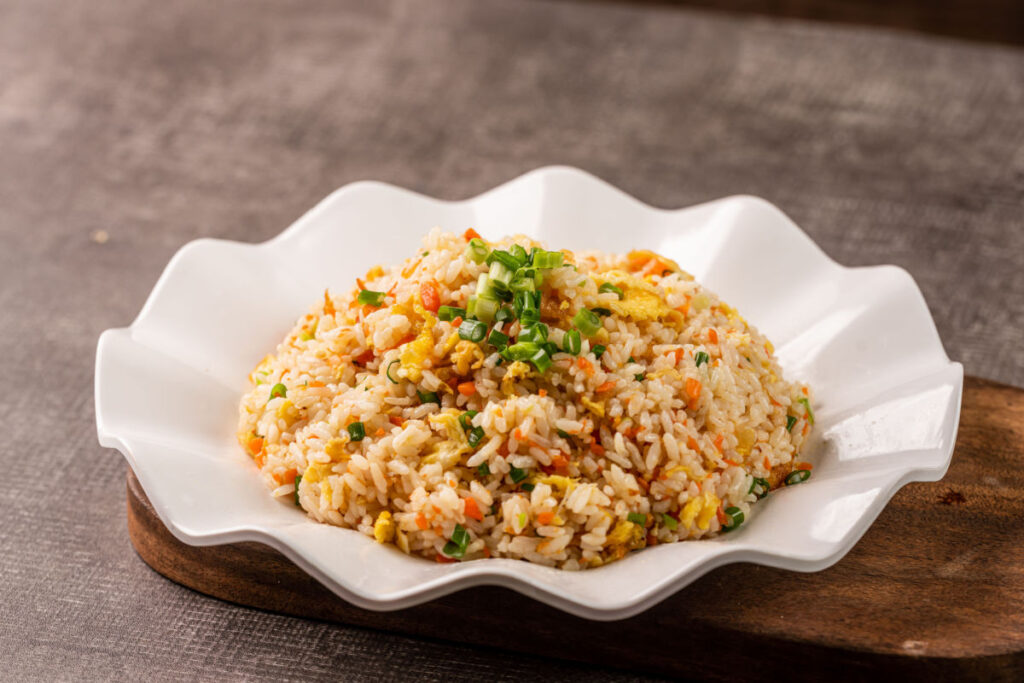
Yes, you read that title correctly.
Fried rice originated in China sometime between 589 and 618 AD; it is one of the most popular Asian dishes and has been adopted by many other Asian countries. It was introduced to Japan during the Tang Dynasty and was immediately adopted into Japanese culture. It’s a white rice-based dish usually accompanied by green onion, vegetables, and meat. It was conceptualized to use up leftover rice and has now, in one way or another, become a staple in Asian cuisine.
Japanese fried rice is a staple here at Kabuto; we are a traditional sushi restaurant in Parkville, MD, as well as Rockville, MD, Roseville, MD, and East Norriton, PA, that values authentic Japanese cuisine. That said, some dishes, like fried rice, embodying decades of culture, come with specific etiquette that should be used during consumption.
When Japan reinvented fried rice, they added and excluded some authentic ingredients and renamed it “Omurice.” This dish consists of stir-frying day-old rice seasoned with white pepper, spring onion, and scrambled egg. Often this dish is served in a hibachi restaurant; the word “hibachi” translates to “fire bowl” in Japanese, relating to the dish’s preparation. Even though Japanese fried rice and Chinese fried rice are very similar, there are some critical differences between the two.
Do’s and Don’ts in Japanese Cuisine
Don’t: Soy Sauce
One could say that soy sauce is the top condiment in Asian cuisine and is used in most dishes across the continent. However, you might be surprised to find out that in some scenarios, it can be deemed disrespectful to add it to your food. In Japan, there are specific etiquette rules expected to be followed by natives and visitors. Therefore, it is looked down upon to put soy sauce on Japanese fried rice.
You might think soy sauce would make the dish more flavorful, but that couldn’t be further from the truth! When soy sauce is added to Japanese fried rice, it detracts from the flavor of the original dish. The soy sauce can make the rice soggy and overpower the taste of the other ingredients. Instead, the country uses other seasonings, such as furikake, green onion, and miso, to add a multitude of flavors.
In addition, soy sauce can also be very salty, so adding it to Japanese fried rice could easily make it too salty for most people. Therefore, whenever you order Japanese fried rice at a hibachi restaurant or make it at home, you should leave the soy sauce off and focus on the other ingredients that give it its unique flavor.
Do: Cook in a Wok
Using the wok when frying the rice is essential; it will cook it differently than any other pan. The wok’s high heat helps create the slightly charred, crispy texture that makes Japanese fried rice so delicious. Alternatively, you can try a hibachi fried rice recipe that calls for adding soy sauce directly to the wok. The work will be kept hot with oil and butter, preventing it from cooling down too much when the soy sauce is added.
Don’t: Use Brown Rice
When making Japanese fried rice, it is essential to use the right types of rice. Generally, it would be best to stick with white rice or a combination of white and brown rice. Brown rice does not break down as quickly as white rice and will not create the desired texture or flavor when stir-frying.
Do: Teriyaki Fried Rice
To get a richer flavor, feel free to use homemade teriyaki sauce! Teriyaki sauce can easily be made with soy sauce (or low-sodium soy sauce), sake, mirin, and sugar. Start by combining all ingredients in a bowl and cooking it on low heat until the liquid reduces and thickens. This method still uses soy sauce on Japanese fried rice but incorporates the condiment more conventionally. Use this homemade teriyaki sauce topping over your fried rice for an extra flavor boost! Japanese natives often eat fried rice with teriyaki and a side of tempura. Tempura is often used to bulk up the meal and to add a new texture to the meal. In terms of tempura, Kabuto’s tempura menu in East Norriton, PA, offers some of the best tempura dishes around.
Book Your Table Now!
The chefs here at Kabuto have perfected the art of authentic Japanese cuisine. We put extensive time and effort into curating every dish to satisfy everyone’s palette. As one of the East Coast’s leading Japanese cuisine restaurants, we deliver on keeping every meal traditional and ensure our use of the freshest ingredients provides an unmatched experience.
Call us now to reserve a table at one of four locations!
